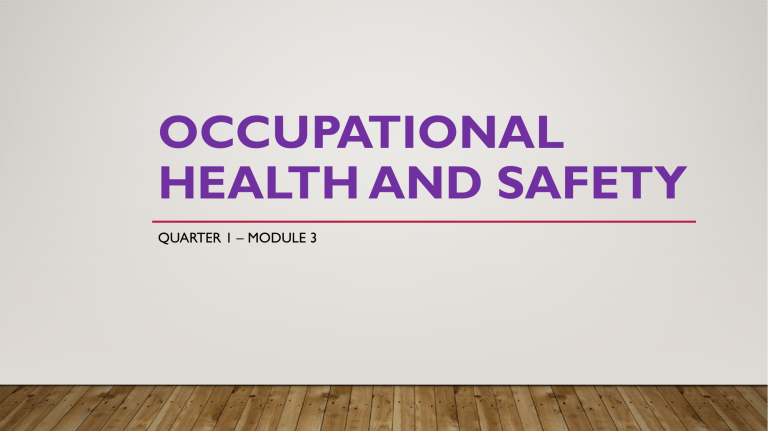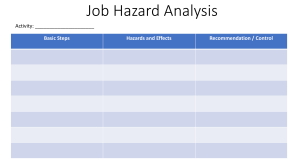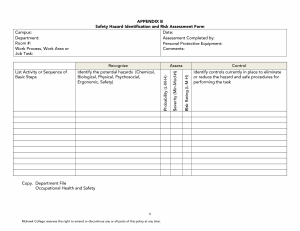Occupational Health & Safety Module for ICT Students
advertisement

OCCUPATIONAL HEALTH AND SAFETY QUARTER 1 – MODULE 3 OCCUPATIONAL HEALTH AND SAFETY (OHS) POLICY An Information and communication technology (ICT) student should know how to behave when working in the computer laboratory, as well as implement a safe way of accomplishing every task. Safety practices should be learned early and always adheres in working with any electrical and electronic device, including personal computers and its peripherals. OCCUPATIONAL HEALTH AND SAFETY (OHS) is a planned system of working to prevent illness and injury where you work by recognizing and identifying hazards and risks. Health and safety procedure are the responsibility of all persons in the computer and technology industries. OCCUPATIONAL HEALTH AND SAFETY STANDARDS Students need to be aware of the type of hazards that are possibly present in their work environment. OCCUPATIONAL HEALTH AND SAFETY STANDARDS Procedure 1. Identify the hazard. 2. Clear the area close to the hazard. 3. Partition the hazard off or clearly identify the area to protect other people from harm. 4. If the hazard is easily and safely cleared, then do so. OCCUPATIONAL HEALTH AND SAFETY STANDARDS If not… 5. Report the hazard to the appropriate person (such as teacher in charge, principal etc.) to obtain assistance 6. Following clearing of the hazard fill out the correct documentation to assist in identifying improved practice to reduce further incidence of hazards. WHAT DO WE NEED TO DO IF WE SAW A HAZARD? All hazards must be reported using Accidental Report Form. This enables us to track the kinds of hazards we have in our workplace and act where necessary to make it safer for all student and clients. ACCIDENT REPORTS Forms are used to give specific details with regards to the accidents happened in the laboratory during experiments. Accident reports contain the following details: • Name of the person injured • Date and time of the accident • Type of injury • First aid given • Action taken to prevent further accidents HAZARDOUS SUBSTANCES If the workplace hazard appears to be dangerous to staff and clients and professional assistance is required: • Call the supervisor or manager and advise them of the problem and the urgency of the matter. • Depending on the risk it may be called as an evacuation. • Follow the evacuation procedure. • The supervisor or manager will call in the fire brigade or specialized personnel who will deal with the spill. FIRE EXITS All fire exits should be kept clear of from obstacles. All students have a responsibility to make sure that chairs, empty boxes or any other type of obstacle are not placed in or near fire exit doorways. FIRE SAFETY PROCEDURE Each work area has a designated fire warden, who in the event of a fire will take charge. They are recognized by the wearing of a red hard hat. WHAT WILL YOU DO IF YOU THE FIRE? • Assess the danger prior to doing anything. • If it is safe to move assist anyone in the vicinity of the fire away from danger. • If it is possible close the door to the fire area. • Call for assistance. Verbally call FIRE, FIRE, in a loud and clear voice. WHAT WILL YOU DO IF YOU THE FIRE? • Break the glass section of the fire alert call point. • Call to the switch; ensure you know where the fire is, any other details that may be of assistance to the fire brigade. Details could be size of the fire, cause or type of fire, any people hurt or trapped, has anyone tried to put it out. • If safe to do so, attack the fire with the correct extinguisher or fire hose. IF THE DESIGNATED FIRE OFFICER IS NOT PRESENT? 1. Locate the source of the fire. 2. Locate any people. 3. Remove all people from the building. 4. Once outside do a head count. 5. Notify the authorities. GROUP ACTIVITY: Directions: Create a list of Personal Safety While Working with PC’s. GROUP ACTIVITY: Using the accident report form, portray two potential hazard that could occur when using computers in the computer lab, and explain what appropriate actions to take.





